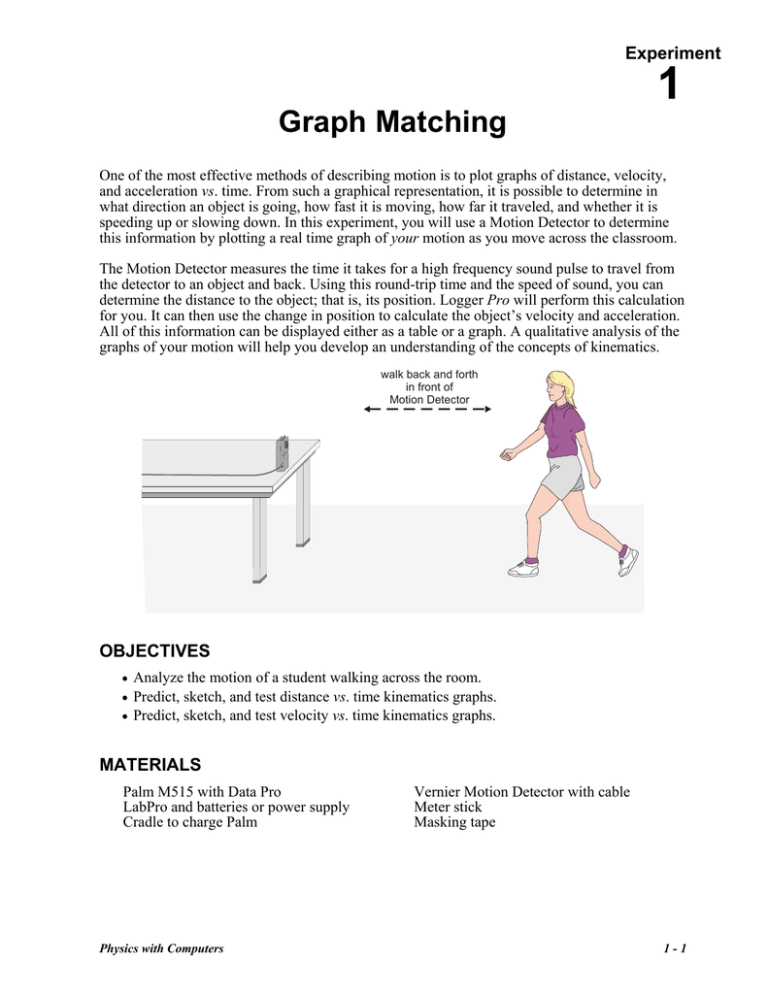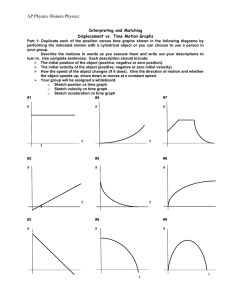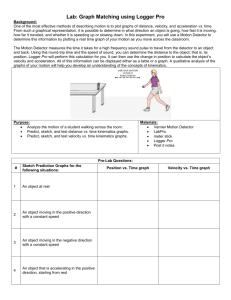1 Graph Matching Experiment
advertisement

Experiment 1 Graph Matching One of the most effective methods of describing motion is to plot graphs of distance, velocity, and acceleration vs. time. From such a graphical representation, it is possible to determine in what direction an object is going, how fast it is moving, how far it traveled, and whether it is speeding up or slowing down. In this experiment, you will use a Motion Detector to determine this information by plotting a real time graph of your motion as you move across the classroom. The Motion Detector measures the time it takes for a high frequency sound pulse to travel from the detector to an object and back. Using this round-trip time and the speed of sound, you can determine the distance to the object; that is, its position. Logger Pro will perform this calculation for you. It can then use the change in position to calculate the object’s velocity and acceleration. All of this information can be displayed either as a table or a graph. A qualitative analysis of the graphs of your motion will help you develop an understanding of the concepts of kinematics. walk back and forth in front of Motion Detector OBJECTIVES • Analyze the motion of a student walking across the room. • Predict, sketch, and test distance vs. time kinematics graphs. • Predict, sketch, and test velocity vs. time kinematics graphs. MATERIALS Palm M515 with Data Pro LabPro and batteries or power supply Cradle to charge Palm Physics with Computers Vernier Motion Detector with cable Meter stick Masking tape 1-1 Experiment 1 PRELIMINARY QUESTIONS 1. Use a coordinate system with the origin at far left and positive distances increasing to the right. Sketch the distance vs. time graph for each of the following situations: • • • • An object at rest An object moving in the positive direction with a constant speed An object moving in the negative direction with a constant speed An object that is accelerating in the positive direction, starting from rest 2. Sketch the velocity vs. time graph for each of the situations described above. PROCEDURE Part l Preliminary Experiments 1. Connect the Motion Detector to DIG/SONIC 1 of the LabPro or PORT 2 of the Universal Lab Interface. (Note that the second input is used in both cases!) 2. Place the Motion Detector so that it points toward an open space at least 4 m long. Use short strips of masking tape on the floor to mark the 1 m, 2 m, 3 m, and 4 m distances from the Motion Detector. 3. Connect Palm to LabPro with cable provided. Remove stylus from Palm and place in cradle of LabPro. Power both the LabPro and the Palm. Select Data Pro from home screen. If main screen reads “Dig/Son1: Dist(M)” you are read y to collect data. When start is tapped a graph should appear. The vertical axis has distance scaled from 0 to 5 meters. The horizontal axis has time scaled from 0 to 10 seconds. 4. If Motion Detector is not on main screen, tap “Set up” then tap “ Dig/Son1:”. Scroll to Motion(M) and select. Tap “OK” to return to set up and “OK” again to return to main screen. 5. Using Data Pro, produce a graph of your motion when you walk away from the detector with constant velocity. To do this, stand about 1 m from the Motion Detector and have your lab partner tap “start”. Walk slowly away from the Motion Detector when you hear it begin to click. 6. Sketch what the distance vs. time graph will look like if you walk faster. Check your prediction with the Motion Detector. 7. Try to match the shape of the distance vs. time graphs that you sketched in the Preliminary Questions section by walking in front of the Motion Detector. 1-2 Physics with Computers Graph Matching Part Il Distance vs. Time Graph Matching 1. Describe how you would walk to produce this target graph. 2. To test your prediction, choose a starting position and stand at that point. Start data collection by tapping ‘start” . When you hear the Motion Detector begin to click, walk in such a way that the graph of your motion matches the target graph. 10. If you were not successful, repeat the process until your motion closely matches the graph on the screen. If a printer is attached, print the graph with your best attempt. 11. Repeat Steps 8 – 10, using a new target graph. 12. Answer the Analysis questions for Part II before proceeding to Part III. Part IIl Velocity vs. Time Graph Matching 13. Change to a velocity v. time graph by tapping the Y axis and selecting Velocity. Physics with Computers 1-3 Experiment 1 14. Describe how you would walk to produce this target graph. 15. To test your prediction, choose a starting position and stand at that point. Start data collection by tapping start. When you hear the Motion Detector begin to click, walk in such a way that the graph of your motion matches the target graph on the screen. It will be more difficult to match the velocity graph than it was for the distance graph. 16. Repeat Steps 14 – 15 to match this graph. 17. Remove the masking tape strips from the floor. ANALYSIS Part II Distance vs. Time Graph Matching 1. Describe how you walked for each of the graphs that you matched. 2. Explain the significance of the slope of a distance vs. time graph. Include a discussion of positive and negative slope. 3. What type of motion is occurring when the slope of a distance vs. time graph is zero? 4. What type of motion is occurring when the slope of a distance vs. time graph is constant? 5. What type of motion is occurring when the slope of a distance vs. time graph is changing? Test your answer to this question using the Motion Detector. 1-4 Physics with Computers Graph Matching 6. Return to the procedure and complete Part III. Part III Velocity vs. Time Graph Matching 7. Describe how you walked for each of the graphs that you matched. 8. Using the velocity vs. time graphs, sketch the distance vs. time graph for each of the graphs that you matched. In Data Pro, switch to a distance vs. time graph to check your answer. Do this by clicking on the y-axis label and unchecking velocity; then check Distance. 9. What does the area under a velocity vs. time graph represent? Test your answer to this question using the Motion Detector. 10. What type of motion is occurring when the slope of a velocity vs. time graph is zero? 11. What type of motion is occurring when the slope of a velocity vs. time graph is not zero? Test your answer using the Motion Detector. EXTENSIONS 1. Create a graph-matching challenge. Sketch a distance vs. time graph on a piece of paper and challenge another student in the class to match your graph. Have the other student challenge you in the same way. 2. Create a velocity vs. time challenge in a similar manner. 3. Create a distance vs. time graph by walking in front of the Motion Detector. Store the graph by choosing Store Latest Run from the Data menu. Have another student match your run. 4. Create a velocity vs. time graph by walking in front of the Motion Detector. Store the graph by choosing Store Latest Run from the Data menu. Have another student match your run. Physics with Computers 1-5




